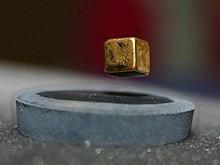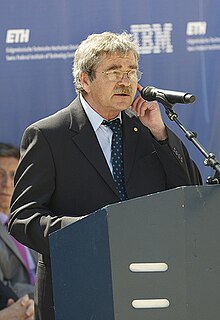Georg Bednorz
Johannes Georg Bednorz (born May 16, 1950 in Neuenkirchen in the Steinfurt district ) is a German mineralogist and physicist . In 1987 he and Karl Alexander Müller received the Nobel Prize in Physics for the discovery of high-temperature superconductors .
Life
The Anton and Elisabeth Bednorz family came from Silesia and were expelled from their homeland at the end of the Second World War . The mother with three children came to Neuenkirchen, where the father found her again in 1949. The father was a teacher at the village school and the mother was a piano teacher. In 1950 Georg Bednorz was born as the fourth and last child of the family in the Neuenkirchen district of St. Arnold . The parents tried to get their son interested in classical music , but initially with little success. Georg Bednorz was more interested in practical work on his brothers' motorcycles and cars. At school, his art teacher promoted practical skills, creativity and team spirit. At the age of 13 Bednorz discovered his love for classical music and played the violin and trumpet in the school orchestra.
His enthusiasm for the natural sciences was originally more in chemistry than in physics. The physics lessons were more theoretical, while chemistry lessons involved practical experiments with often unpredictable results. After High School on school Martinum in Emsdetten Bednorz began in 1968 a study chemistry at the Westphalian Wilhelms University in Münster . Since he felt lost among the many students and also had not passed the entrance exams for the introductory chemical internship, he switched to mineralogy . He wrote his diploma thesis under the supervision of Wolfgang Hoffmann in the subfield of crystallography on synthetic perovskites .
In the summer of 1972 Bednorz first worked as a summer student at the IBM Zurich Research Laboratory in Rüschlikon . After a second visit in 1973, he came to Switzerland for six months in 1974 to do the experiments there under the direction of Hans Jörg Scheel for his diploma thesis on the characterization and crystal growth of perovskites ( SrTiO 3 ). After another year in Münster, Bednorz began his doctorate in 1977 at the Laboratory for Solid State Physics at ETH Zurich under the supervision of Heini Gränicher and Karl Alexander Müller .
Research on high temperature superconductivity

After Bednorz started working at IBM in 1982, he and Karl Alexander Müller began his research in 1983 on high-temperature superconductivity in ceramics made from copper oxides. A publication by AW Sleight , JL Gillson and PE Bierstedt indicated that there are potential superconductors under oxides. This was an unconventional idea at the time as these materials were only known as insulators or semiconductors . At that time, superconductivity was only known for a few metals. The hitherto highest transition temperature of 23 Kelvin was achieved by an alloy of germanium and niobium . In 1986 Bednorz and Müller were able to detect a transition temperature of 35 Kelvin for a barium-lanthanum cuprate (La 1.85 Ba 0.15 CuO 4 ) for the first time. At the time, this was the highest temperature ever measured for superconductivity.
1987 Nobel Prize in Physics
In April 1986 Bednorz and Müller published their results, which were subsequently confirmed several times by other scientists. For their groundbreaking discovery of superconductivity in ceramic materials, both received the Nobel Prize in Physics the following year (1987) . This was the shortest time interval between a discovery and the award of a Nobel Prize - closely followed by the experimental evidence of gravitational waves , which was published in February 2016 and was also awarded the Nobel Prize in the following year (2017).
Further research and applications
After the publications and the Nobel Prize, many scientists engaged in research on the discovered phenomenon. After his research work at IBM, he worked as a consultant for applications of superconductors. Since the breakthrough by Bednorz and Müller, many new material mixtures have been investigated and ever higher transition temperatures have been reached, so that inexpensive liquid nitrogen was soon sufficient for cooling the superconductors. Loss-free power transmission could thus be tested in practice. A superconducting 10 kV high voltage line has been in operation in the city of Essen since April 2014. The subject of further research are superconducting motors and generators, as well as superconducting magnetic bearings and superconducting magnetic energy storage devices .
Honors
In 1987 Bednorz was appointed an IBM Fellow . In 1998 he became a Fellow of the American Physical Society , and in 2018 he was elected to the National Academy of Sciences .
The universities of Salzburg , Regensburg, Tbilisi and Katowice have awarded him an honorary doctorate, and in 2018 the Westphalian Wilhelms University of Münster .
Bednorz is an honorary citizen of Emsdetten. Georg-Bednorz-Strasse is named after him in Neuenkirchen, where he was born. In the district of St. Arnold , the community had a plaque attached to the house where he was born.
Scientific awards
In addition to the Nobel Prize, Bednorz received the following awards:
- Marcel Benoist Prize (1986)
- Minnie Rosen Award (1986)
- Viktor Moritz Goldschmidt Prize (1986)
- Klung Wilhelmy Weberbank Prize (1987)
- Fritz London Memorial Prize (1987)
- Dannie Heineman Prize of the Göttingen Academy of Sciences (1987)
- Robert Wichard Pohl Prize (1987)
- Hewlett-Packard Europhysics Prize (1988)
- APS International Prize for Materials Research (1988)
Web links
- Literature by and about Georg Bednorz in the catalog of the German National Library
- Information from the Nobel Foundation on the award ceremony 1987 to Johannes Georg Bednorz (English)
Individual evidence
- ^ Nobelprize.org: The Nobel Prize in Physics 1987 .
- ^ J. Georg Bednorz - Biographical Retrieved April 17, 2015.
- ↑ AW Sleight, JL Gillson, PE Bierstedt: High-temperature superconductivity in the BaPb 1-x Bi x O 3 system . In: Solid State Communications . 17, 1975, pp. 27-28. doi : 10.1016 / 0038-1098 (75) 90327-0 .
- ↑ Power lines and suspension railways: superconductors are conquering the world , Bednorz interview with Markus Keßler, September 17, 2018, futurezone
- ↑ "We don't know ourselves why high-temperature superconductors work." Interview by Fabian Schmidt (Deutsche Welle) with Georg Bednorz (October 28, 2014).
- ↑ AmpaCity - technological world premiere in Essen http://www.rwe.com/web/cms/de/1301026/rwe-deutschland-ag/energiewende/intelligente-netze/ampacity/ ( Memento from January 24, 2015 in the Internet Archive ) Retrieved April 17, 2015.
- ↑ APS Fellow Archive. Retrieved February 11, 2020 .
- ↑ University of Münster University Council ( Memento of the original from February 10, 2015 in the Internet Archive ) Info: The archive link was automatically inserted and not yet checked. Please check the original and archive link according to the instructions and then remove this notice. Retrieved February 10, 2015.
- ↑ Christina Heimken: Department of Physics at the WWU Münster awards an honorary doctorate to Dr. Johannes Georg Bednorz. Westfälische Wilhelms-Universität Münster, press release from July 13, 2018 from the Science Information Service (idw-online.de), accessed on July 13, 2018.
| personal data | |
|---|---|
| SURNAME | Bednorz, Georg |
| ALTERNATIVE NAMES | Bednorz, Johannes Georg |
| BRIEF DESCRIPTION | German physicist and mineralogist |
| DATE OF BIRTH | May 16, 1950 |
| PLACE OF BIRTH | Neuenkirchen , Steinfurt district |


